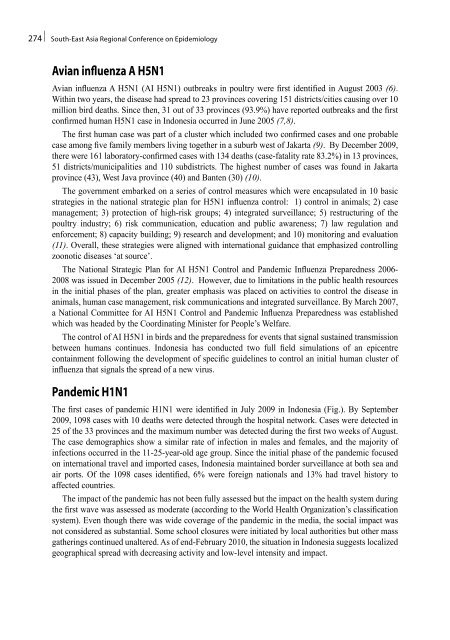South-East Asia Regional Conference on Epidemiology
South-East Asia Regional Conference on Epidemiology
South-East Asia Regional Conference on Epidemiology
You also want an ePaper? Increase the reach of your titles
YUMPU automatically turns print PDFs into web optimized ePapers that Google loves.
274 | <str<strong>on</strong>g>South</str<strong>on</strong>g>-<str<strong>on</strong>g>East</str<strong>on</strong>g> <str<strong>on</strong>g>Asia</str<strong>on</strong>g> <str<strong>on</strong>g>Regi<strong>on</strong>al</str<strong>on</strong>g> <str<strong>on</strong>g>C<strong>on</strong>ference</str<strong>on</strong>g> <strong>on</strong> <strong>Epidemiology</strong><br />
Avian influenza A H5N1<br />
Avian influenza A H5N1 (AI H5N1) outbreaks in poultry were first identified in August 2003 (6).<br />
Within two years, the disease had spread to 23 provinces covering 151 districts/cities causing over 10<br />
milli<strong>on</strong> bird deaths. Since then, 31 out of 33 provinces (93.9%) have reported outbreaks and the first<br />
c<strong>on</strong>firmed human H5N1 case in Ind<strong>on</strong>esia occurred in June 2005 (7,8).<br />
The first human case was part of a cluster which included two c<strong>on</strong>firmed cases and <strong>on</strong>e probable<br />
case am<strong>on</strong>g five family members living together in a suburb west of Jakarta (9). By December 2009,<br />
there were 161 laboratory-c<strong>on</strong>firmed cases with 134 deaths (case-fatality rate 83.2%) in 13 provinces,<br />
51 districts/municipalities and 110 subdistricts. The highest number of cases was found in Jakarta<br />
province (43), West Java province (40) and Banten (30) (10).<br />
The government embarked <strong>on</strong> a series of c<strong>on</strong>trol measures which were encapsulated in 10 basic<br />
strategies in the nati<strong>on</strong>al strategic plan for H5N1 influenza c<strong>on</strong>trol: 1) c<strong>on</strong>trol in animals; 2) case<br />
management; 3) protecti<strong>on</strong> of high-risk groups; 4) integrated surveillance; 5) restructuring of the<br />
poultry industry; 6) risk communicati<strong>on</strong>, educati<strong>on</strong> and public awareness; 7) law regulati<strong>on</strong> and<br />
enforcement; 8) capacity building; 9) research and development; and 10) m<strong>on</strong>itoring and evaluati<strong>on</strong><br />
(11). Overall, these strategies were aligned with internati<strong>on</strong>al guidance that emphasized c<strong>on</strong>trolling<br />
zo<strong>on</strong>otic diseases ‘at source’.<br />
The Nati<strong>on</strong>al Strategic Plan for AI H5N1 C<strong>on</strong>trol and Pandemic Influenza Preparedness 2006-<br />
2008 was issued in December 2005 (12). However, due to limitati<strong>on</strong>s in the public health resources<br />
in the initial phases of the plan, greater emphasis was placed <strong>on</strong> activities to c<strong>on</strong>trol the disease in<br />
animals, human case management, risk communicati<strong>on</strong>s and integrated surveillance. By March 2007,<br />
a Nati<strong>on</strong>al Committee for AI H5N1 C<strong>on</strong>trol and Pandemic Influenza Preparedness was established<br />
which was headed by the Coordinating Minister for People’s Welfare.<br />
The c<strong>on</strong>trol of AI H5N1 in birds and the preparedness for events that signal sustained transmissi<strong>on</strong><br />
between humans c<strong>on</strong>tinues. Ind<strong>on</strong>esia has c<strong>on</strong>ducted two full field simulati<strong>on</strong>s of an epicentre<br />
c<strong>on</strong>tainment following the development of specific guidelines to c<strong>on</strong>trol an initial human cluster of<br />
influenza that signals the spread of a new virus.<br />
Pandemic H1N1<br />
The first cases of pandemic H1N1 were identified in July 2009 in Ind<strong>on</strong>esia (Fig.). By September<br />
2009, 1098 cases with 10 deaths were detected through the hospital network. Cases were detected in<br />
25 of the 33 provinces and the maximum number was detected during the first two weeks of August.<br />
The case demographics show a similar rate of infecti<strong>on</strong> in males and females, and the majority of<br />
infecti<strong>on</strong>s occurred in the 11-25-year-old age group. Since the initial phase of the pandemic focused<br />
<strong>on</strong> internati<strong>on</strong>al travel and imported cases, Ind<strong>on</strong>esia maintained border surveillance at both sea and<br />
air ports. Of the 1098 cases identified, 6% were foreign nati<strong>on</strong>als and 13% had travel history to<br />
affected countries.<br />
The impact of the pandemic has not been fully assessed but the impact <strong>on</strong> the health system during<br />
the first wave was assessed as moderate (according to the World Health Organizati<strong>on</strong>’s classificati<strong>on</strong><br />
system). Even though there was wide coverage of the pandemic in the media, the social impact was<br />
not c<strong>on</strong>sidered as substantial. Some school closures were initiated by local authorities but other mass<br />
gatherings c<strong>on</strong>tinued unaltered. As of end-February 2010, the situati<strong>on</strong> in Ind<strong>on</strong>esia suggests localized<br />
geographical spread with decreasing activity and low-level intensity and impact.









